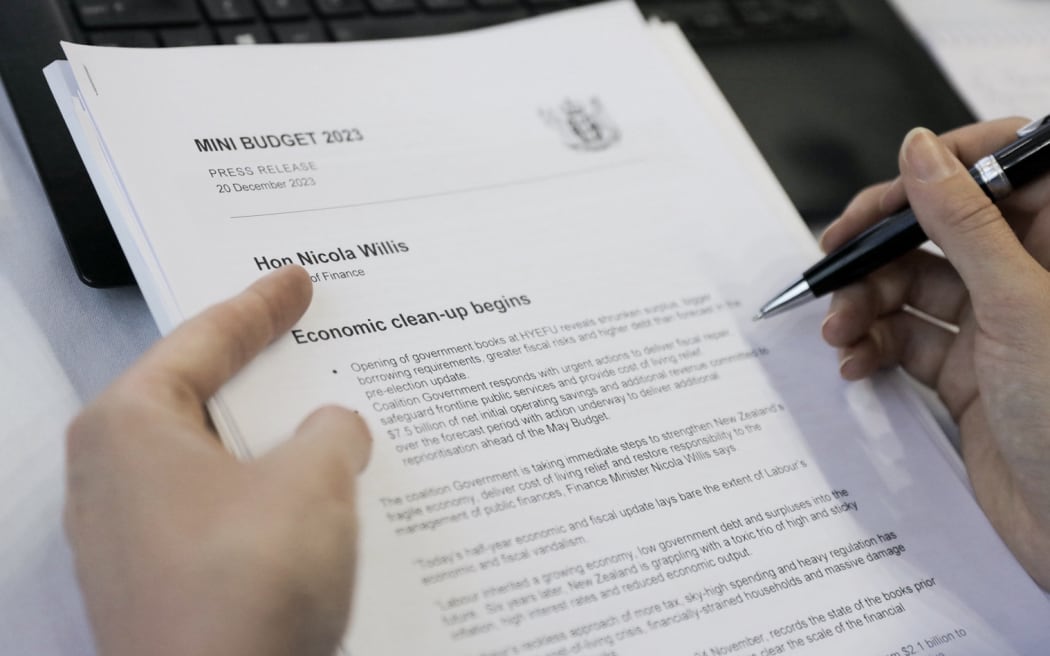Navigation for News Categories
Photo: RNZ / Samuel Rillstone
The government says it has started a multi-billion dollar repair job as a new set of forecasts showed a worsening economic outlook and government’s financial position in the next few years.
The Half Year Economic and Fiscal Update (HYEFU) showed the expected deficit for the year to next June would be lower because of the influx of migrants, but sluggish growth would mean sizeable deficits before the return to a smaller than expected surplus in 2026/27.
Finance Minister Nicola Willis said the government had started the economic clean up, after the Labour government’s “economic and fiscal vandalism”.
“New Zealand is grappling with a toxic trio of high and sticky inflation, high interest rates, and reduced economic output”.
The mini-budget outlined a range of cost savings and new revenue totalling $7.5 billion over the next five years through already advised policy changes such as axing clean car discounts, early childhood subsidies, and ending big projects.
Willis said 88 “fiscal risks” had been identified from Labour failing to adequately future fund committed policies.
However, the main forecasts in the HYEFU did not include the recent economic numbers, notably the surprise fall in growth in the third quarter, nor the direct impact of the new government’s policies.
The Treasury said the government’s planned tax cuts starting from next year were expected to be “neutral” for government finances over the five-year forecast period.
Key economic numbers (for year ended June 2024 vs Pre-election forecasts)
(Forecasts do not include impact of mini-Budget, recent data)
GDP (annual) 1.5 pct vs 1.3 pct
Inflation 4.1 pct vs 3.8 pct
Unemployment 4.5 pct vs 4.8 pct
Current acct -5.7 pct/GDP vs -6.6 pct
Key fiscal numbers (for year ended June 2024 vs Pre-election forecasts)
(Forecasts do not include impact of mini-Budget, recent data)
Core tax revenue $122b vs $121.6b
Core expenses $140.3b vs $139.4b
OBEGAL (budget balance) -$9.3 vs -$11.4b
Net debt (pct GDP) 23.2 vs 22.3
Govt net bond issue to 2027 $56.7b vs $49.3b
Impact of mini-Budget on finances 2024-2028
Core tax revenue: unchanged 2024/25; +$1.1b 2026; +$0.5b 2027; +$0.5b 2028. Total fcst period +$2.1b
Core expenses -$0.2b 2024; -$1.2b 2025; -$1.4b 2026; -$1.6b 2027; -$1.0b 2028. Total fcst period -$5.4b.
The Treasury forecasts generally showed an economy facing two years of sluggish growth, but supported by the strong migration gains and tourism.
Other indicators such as inflation, unemployment, and trade were little changed from the September PREFU, and the expectation that immigration would slow to more normal levels.
However, higher interest rates and pressure on revenue and expenses were expected to result in higher debt and require $7b extra borrowing over the next three years.
Net debt was forecast to peak at 23.3 percent of GDP in 2025 before declining to 19.3 percent in 2028.
Willis said a budget policy statement would be released in March, which would contain the amounts the government would commit to operational spending and the amount would be smaller.
Get the RNZ app
for ad-free news and current affairs


>>> Read full article>>>
Copyright for syndicated content belongs to the linked Source : RNZ – https://www.rnz.co.nz/news/business/505193/government-books-show-worsening-outlook-deficit-curbed-by-immigration
































